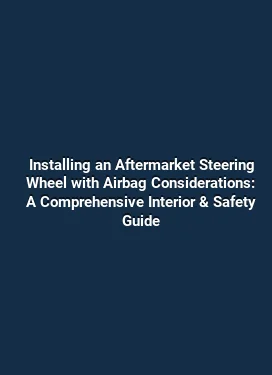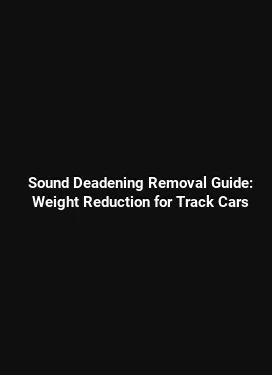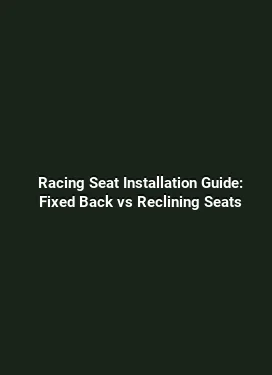Best Harness Pads for Comfort During Long Track Sessions
Long track days demand gear that remains comfortable, secure, and supportive from the first lap to the last. Harness pads play a key role in reducing friction, distributing pressure, and maintaining a stable posture through hours of driving. This guide dives into the most effective harness pad designs, the materials that deliver real value, and practical considerations for choosing pads that fit both the vehicle and the driver’s physique. By focusing on ergonomic design, moisture management, and durability, riders can minimize fatigue and stay focused on precision and control throughout extended sessions.
Understanding Pad Architecture: How Comfort Becomes Performance

Harness pads are not all created equal. The most comfortable options share a few core characteristics: a contoured shape that follows the driver’s torso, high-density foam or gel-infused cores for even pressure distribution, and a cover material that breathes while resisting abrasion. The architecture of a pad influences how weight is distributed across contact points such as the shoulders, chest, and upper back. A well-designed pad reduces pinching at movement corners, prevents heat buildup in high-friction zones, and stays in place without requiring constant readjustment. When evaluating pads, it helps to visualize how the pad will behave under dynamic loads—reaching for a steering wheel, shifting weight in a turn, and absorbing minor impacts from track irregularities.
Key factors to consider include inner core composition (memory foam, high-density foam, or gel blends), outer fabric (breathable, moisture-wicking options with low friction), and attachment methods (strap systems, hook-and-loop closures, or integrated mounting plates). A pad that combines a firm, supportive core with a soft, durable cover often delivers the most reliable comfort across long sessions.
Pad Core Materials and Their Impact on Comfort

Dense foam cores provide consistent support without excessive compression, which helps maintain posture even during repetitive braking and acceleration. Gel-infused foams add a cooling effect by absorbing heat generated through prolonged contact with the torso, which can be especially beneficial in warmer climates or vehicles with limited airflow. Hybrid foams blend the best of both worlds, offering gentle contouring in high-pressure zones while resisting bottoming out during aggressive maneuvers. When comparing pads, test how the material responds to weight shifts and torso movements; you want a core that rebounds quickly to maintain support after each motion.
Another important consideration is edge design. Pads with softly rounded edges reduce the likelihood of chafing at the neck and shoulder joints, a common irritation after multiple laps. Some pads incorporate zoned stiffness, with a stiffer midsection to support the sternum area and a slightly more forgiving perimeter to accommodate natural body movement.
Breathability and Moisture Management: Staying Dry Under Pressure
Comfort on the track is as much about temperature regulation as it is about cushioning. Pads with moisture-wicking linings and breathable outer fabrics help manage sweat buildup, which can otherwise lead to skin irritation and reduced grip due to damp clothing. Look for materials like moisture-wicking synthetics or performance fabrics that pull moisture away from the skin and allow for rapid evaporation. A breathable mesh backing can also improve air circulation between the back and the pad, reducing heat accumulation during long sessions.
Heat management becomes especially important when wearing undershirts or base layers. A pad that works well with common racing apparel should not trap heat against the back. Some pads feature perforated foam or small vent channels that promote airflow without compromising structural integrity. If you frequently race in humid environments, prioritize pads with these features to maintain comfort over time.
Thermal Comfort Versus Protective Performance
There is a balance to strike between thermal comfort and protective performance. Some pads include additional padding layers that absorb impact from jolts or minor collisions while still allowing heat to escape. For drivers who frequently run longer sessions or endurance events, this equilibrium becomes a practical factor in choosing the right model. Pads with removable or washable covers also simplify hygiene maintenance, which indirectly supports longer, more comfortable use without skin irritation from sweat buildup.
Fit and Positioning: Ensuring a Secure, Consistent Contact Zone
A pad only delivers benefits if it fits properly. Ill-fitting pads can bunch, shift, or press uncomfortably against the collarbone or spine. Accurate sizing begins with measuring torso length, shoulder width, and chest circumference, then matching these measurements to the pad’s dimensions and mounting options. Some pads offer multiple thickness options or adjustable mounting heights to tailor the fit to a particular seat and belt configuration. The goal is to create an even contact surface that distributes load without creating pressure points.
Attachment systems are a major part of fit. Pads with adjustable straps allow micro-tuning of pad position, critical when a driver changes seating position or when experimenting with different steering wheel heights. If a pad is too tight, it can restrict range of motion; if too loose, it may shift, reducing effectiveness during aggressive driving. A secure, intuitive attachment method minimizes movement and keeps the pad aligned with the torso for consistent protection and comfort across laps.
Test and Tweak: Adapting Pads to Your Vehicle
Every car seat, harness configuration, and driver physique create a unique comfort profile. A practical approach is to try a pad during a routine track session, note any hotspots, slipping, or rubbing, and adjust the position accordingly. If possible, perform a few laps with and without the pad to compare pressure distribution and postural cues. Small changes, like lowering the pad slightly or adjusting the strap tension, can yield noticeable improvements in comfort and control over time.
Durability and Maintenance: Lengthening Pad Lifespan for Repeated Sessions
Long track sessions demand pads that withstand frequent sweat exposure, friction, and occasional impacts from minor seat movement. Durable covers made from abrasion-resistant fabrics resist pilling and tearing, while reinforced stitching around attachment points prevents early failure. Removable, washable covers simplify upkeep and reduce odor buildup, a common concern for drivers logging heavy miles. The inner core should resist permanent compression, maintaining supportive properties even after thousands of cycles of compression and decompression.
When considering maintenance routines, check care labels for washing instructions. Hand-washing or gentle machine cycles with mild detergents help preserve fabric integrity and padding structure. Avoid high heat during drying, which can warp foams or degrade fabric. Regular inspection for signs of wear—such as cracking, exposed foam, or loosened straps—enables timely replacement and maintains consistent comfort and protection on the track.
Material Longevity: Choosing Pads That Stand Up to Repetition
Premium pads often leverage blends designed for longevity: synthetic leather or vinyl coverings with reinforced stitching, closed-cell foams that resist moisture absorption, and anti-microbial treatments to minimize odor. While these features may add to upfront cost, they typically translate into lower replacement frequency and more reliable performance over multiple seasons. For the practical racer, selecting a pad with durable materials and straightforward maintenance is a strategic choice that pays off in reliability and comfort across long-term use.
Practical Recommendations: Pad Choices for Different Track Scenarios
Track environments vary, and so do comfort needs. A few practical recommendations help guide selection based on typical use cases: endurance practice days, sprint events with cooling challenges, and spring or autumn sessions where temperature swings affect skin comfort. For endurance-focused sessions, prioritize pads with a robust core, breathable covers, and secure attachment that minimizes shifting. In hotter climates or indoor venues, emphasize moisture-wicking properties and vented designs. For cooler conditions, the ability to add or layer covers without losing fit becomes valuable. Tailoring pad choice to the track profile and season ensures consistent comfort and performance across diverse sessions.
Additionally, consider compatibility with existing belt routing and shoulder strap designs. Pads that integrate smoothly with the belt path reduce interference and ensure that the belt maintains its protective function without compromising comfort. When in doubt, consult with a technical specialist or the pad manufacturer about fitment for a specific vehicle model and seating setup.
Installation Tips for a Secure Setup
Begin by aligning the pad with the sternum and upper back regions, ensuring that no fabric bunches near the neck. Attach the straps or mounting hardware at the recommended anchor points to prevent loosening during dynamic movement. After initial installation, perform a test drive on a closed course to evaluate whether the pad remains in place through steering inputs, cornering, and braking. If movement occurs, tighten straps gradually and recheck the alignment. A properly installed harness pad will remain stable, distributing load evenly and reducing the risk of rubbing or shifting during aggressive maneuvers.
Conclusion: A Practical Path to Enhanced Comfort and Safety
Choosing the right harness pads involves balancing cushioning, breathability, fit, and durability. By understanding how pad architecture affects load distribution, prioritizing moisture management for comfort during long sessions, and ensuring a secure fit that stays in place under dynamic driving conditions, drivers can achieve meaningful gains in comfort and performance. The most effective pads deliver a calm, supported driving posture, keep friction points minimized, and withstand the rigors of frequent track use, turning long sessions into precise, high-confidence experiences without distraction.






